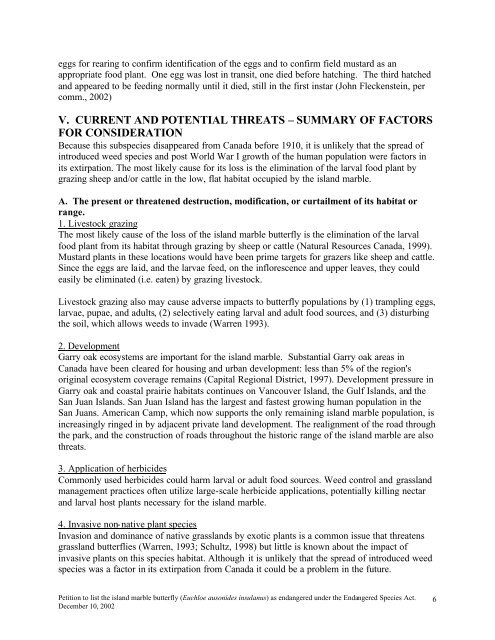island marble - The Xerces Society
island marble - The Xerces Society
island marble - The Xerces Society
Create successful ePaper yourself
Turn your PDF publications into a flip-book with our unique Google optimized e-Paper software.
eggs for rearing to confirm identification of the eggs and to confirm field mustard as an<br />
appropriate food plant. One egg was lost in transit, one died before hatching. <strong>The</strong> third hatched<br />
and appeared to be feeding normally until it died, still in the first instar (John Fleckenstein, per<br />
comm., 2002)<br />
V. CURRENT AND POTENTIAL THREATS – SUMMARY OF FACTORS<br />
FOR CONSIDERATION<br />
Because this subspecies disappeared from Canada before 1910, it is unlikely that the spread of<br />
introduced weed species and post World War I growth of the human population were factors in<br />
its extirpation. <strong>The</strong> most likely cause for its loss is the elimination of the larval food plant by<br />
grazing sheep and/or cattle in the low, flat habitat occupied by the <strong>island</strong> <strong>marble</strong>.<br />
A. <strong>The</strong> present or threatened destruction, modification, or curtailment of its habitat or<br />
range.<br />
1. Livestock grazing<br />
<strong>The</strong> most likely cause of the loss of the <strong>island</strong> <strong>marble</strong> butterfly is the elimination of the larval<br />
food plant from its habitat through grazing by sheep or cattle (Natural Resources Canada, 1999).<br />
Mustard plants in these locations would have been prime targets for grazers like sheep and cattle.<br />
Since the eggs are laid, and the larvae feed, on the inflorescence and upper leaves, they could<br />
easily be eliminated (i.e. eaten) by grazing livestock.<br />
Livestock grazing also may cause adverse impacts to butterfly populations by (1) trampling eggs,<br />
larvae, pupae, and adults, (2) selectively eating larval and adult food sources, and (3) disturbing<br />
the soil, which allows weeds to invade (Warren 1993).<br />
2. Development<br />
Garry oak ecosystems are important for the <strong>island</strong> <strong>marble</strong>. Substantial Garry oak areas in<br />
Canada have been cleared for housing and urban development: less than 5% of the region's<br />
original ecosystem coverage remains (Capital Regional District, 1997). Development pressure in<br />
Garry oak and coastal prairie habitats continues on Vancouver Island, the Gulf Islands, and the<br />
San Juan Islands. San Juan Island has the largest and fastest growing human population in the<br />
San Juans. American Camp, which now supports the only remaining <strong>island</strong> <strong>marble</strong> population, is<br />
increasingly ringed in by adjacent private land development. <strong>The</strong> realignment of the road through<br />
the park, and the construction of roads throughout the historic range of the <strong>island</strong> <strong>marble</strong> are also<br />
threats.<br />
3. Application of herbicides<br />
Commonly used herbicides could harm larval or adult food sources. Weed control and grassland<br />
management practices often utilize large-scale herbicide applications, potentially killing nectar<br />
and larval host plants necessary for the <strong>island</strong> <strong>marble</strong>.<br />
4. Invasive non-native plant species<br />
Invasion and dominance of native grasslands by exotic plants is a common issue that threatens<br />
grassland butterflies (Warren, 1993; Schultz, 1998) but little is known about the impact of<br />
invasive plants on this species habitat. Although it is unlikely that the spread of introduced weed<br />
species was a factor in its extirpation from Canada it could be a problem in the future.<br />
Petition to list the <strong>island</strong> <strong>marble</strong> butterfly (Euchloe ausonides insulanus) as endangered under the Endangered Species Act.<br />
December 10, 2002<br />
6
















